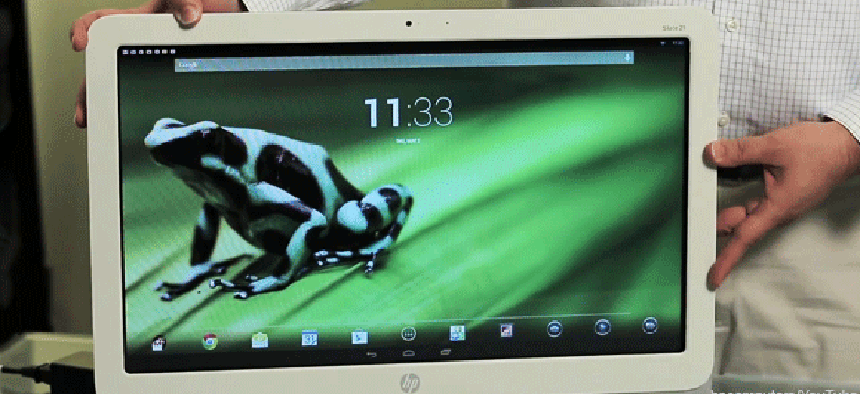Will an Android on the desktop take off for government users?


Connecting state and local government leaders
HP is set to debut the Slate21, an Android-based desktop with a low-cost upgrade path and options for user sharing that could put it in the government buy basket.
Hewlett-Packard is the latest company to try to merge PC performance with the Android operating system. Its new desktop device, called the Slate21, was on display at a convention in Beijing and discussed on the company blog. It's set to launch in the United States in September with a $399 price tag.
This isn't the first Android desktop to be announced, though it may be the first one to actually become available in the United States. Computerworld reported on Acer's efforts to create something similar via the Gateway brand, but it's not scheduled to hit U.S. shores until October.
The Slate21 isn't a typical desktop. It's basically a 21-inch tablet with a kickstand that can be used in ways a desktop would be deployed. Besides the obviously larger screen than the typical Android smartphone or tablet, the Slate21 has several other advantages that might make it attractive to buyers.
The biggest one is probably the addition of the KingSoft office software suite. We've looked at it before and it provides a great desktop experience on Android devices. Couple that with the larger screen and touch capabilities, and it makes the Slate21 a fairly powerful workstation, at least compared to almost any other mobile device. Another advantage that can't be overlooked is the fact that the Slate21 has USB driver recognition, so adding a keyboard or even a mouse is a simple step that brings the device into the realm of a true desktop.
Eric Wiggins, global product marketing manager for HP's PC division, has it right in his comments on the HP blog: "Mobile form-factors such as tablets and phones aren’t exactly optimized for desktop productivity, so we leveraged KingSoft office software as well as additional languages for the physical keyboard."
It's true that some phones simply don’t work well for applications like database management because their screens can't display enough information, so a larger screen is good. But there are other advantages to going big, namely the internal components don’t have to be sacrificed because of size.
The Slate21 will have an Nvidia’s Tegra 4 processor, 8G of internal storage capacity and run the Jellybean version 4.2.2 of the OS. Amazingly, HP says that like a desktop, the Slate21 will also have an upgrade path. So when applications start to outpace the Tegra 4 processor, users should be able to upgrade to something faster without having to purchase a new tablet. That could be a huge advantage for government agencies because not only will they be able to justify getting a unit with the low initial cost, but be able to future proof it.
There is one more advantage hidden within the Slate21 specs. It's powerful enough to allow for multiple users, each with his own desktop environment and application access. In fact, each Slate21 will support five users. That could mean that government offices or schools that might not be able to justify buying a computer for each user could purchase fewer units and share them among users.
A step up from a virtual kiosk, each user would have access to his own applications without interfering with others who would occasionally need to make the device to do something else. As a final cap to this effort, each Slate21 will come with Splashtop2 HD remote desktop software so that it can connect to, and even control, existing Windows PCs that are already part of the enterprise network.
Looking at the specifications, the sharing features and especially the price, it seems that the new Android desktop would be a good fit for government. Despite robust security features, government has been slow to embrace Microsoft Windows 8 based desktops. Perhaps devices like the Slate21 could be an alternative. Although it would likely need to add a fingerprint or CAC card reader to be truly adopted by government, the Slate21 looks like it’s headed in the right direction.




